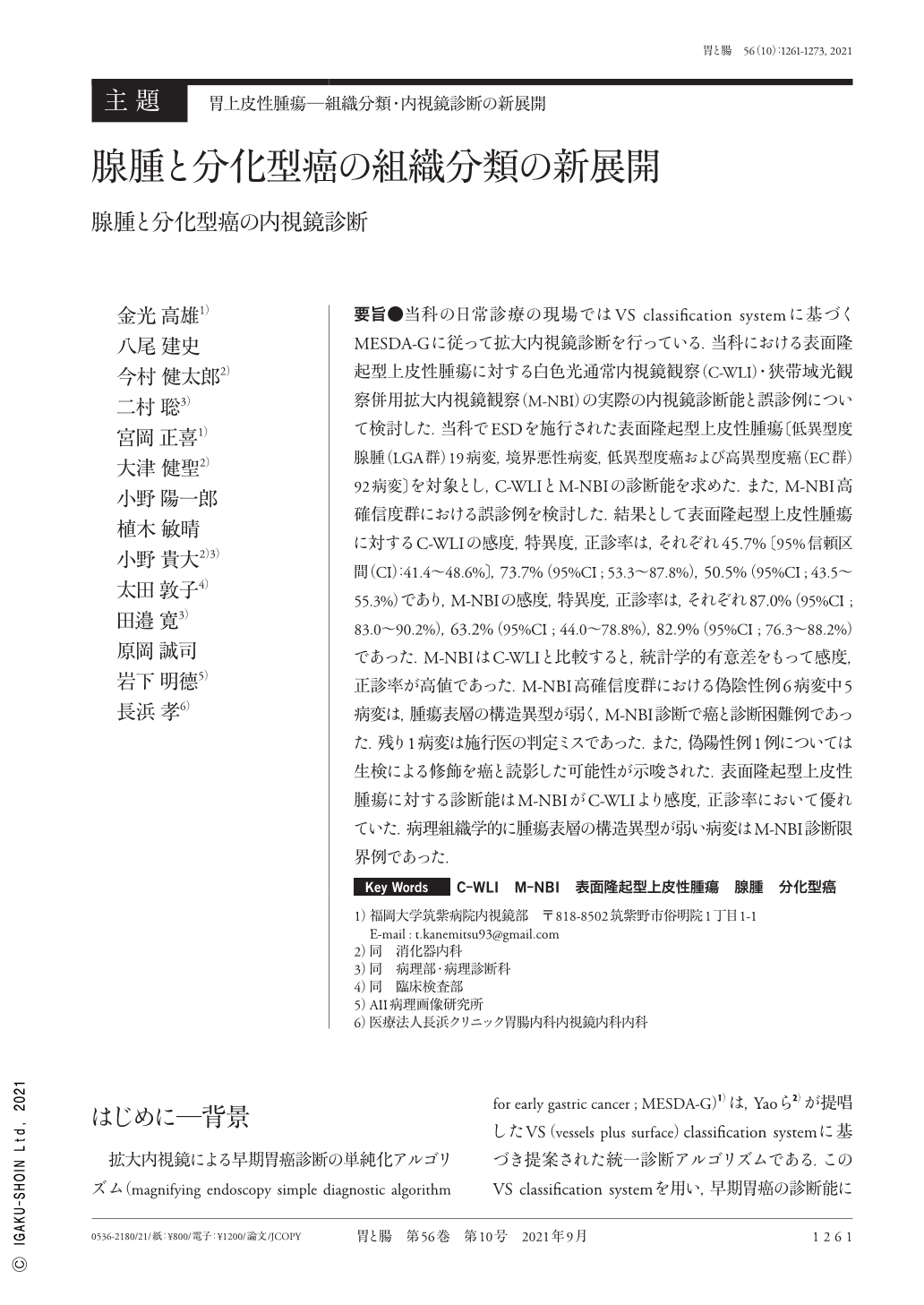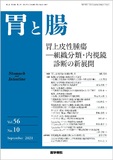Japanese
English
- 有料閲覧
- Abstract 文献概要
- 1ページ目 Look Inside
- 参考文献 Reference
要旨●当科の日常診療の現場ではVS classification systemに基づくMESDA-Gに従って拡大内視鏡診断を行っている.当科における表面隆起型上皮性腫瘍に対する白色光通常内視鏡観察(C-WLI)・狭帯域光観察併用拡大内視鏡観察(M-NBI)の実際の内視鏡診断能と誤診例について検討した.当科でESDを施行された表面隆起型上皮性腫瘍〔低異型度腺腫(LGA群)19病変,境界悪性病変,低異型度癌および高異型度癌(EC群)92病変〕を対象とし,C-WLIとM-NBIの診断能を求めた.また,M-NBI高確信度群における誤診例を検討した.結果として表面隆起型上皮性腫瘍に対するC-WLIの感度,特異度,正診率は,それぞれ45.7%〔95%信頼区間(CI):41.4〜48.6%〕,73.7%(95%CI ; 53.3〜87.8%),50.5%(95%CI ; 43.5〜55.3%)であり,M-NBIの感度,特異度,正診率は,それぞれ87.0%(95%CI ; 83.0〜90.2%),63.2%(95%CI ; 44.0〜78.8%),82.9%(95%CI ; 76.3〜88.2%)であった.M-NBIはC-WLIと比較すると,統計学的有意差をもって感度,正診率が高値であった.M-NBI高確信度群における偽陰性例6病変中5病変は,腫瘍表層の構造異型が弱く,M-NBI診断で癌と診断困難例であった.残り1病変は施行医の判定ミスであった.また,偽陽性例1例については生検による修飾を癌と読影した可能性が示唆された.表面隆起型上皮性腫瘍に対する診断能はM-NBIがC-WLIより感度,正診率において優れていた.病理組織学的に腫瘍表層の構造異型が弱い病変はM-NBI診断限界例であった.
Although magnifying endoscopic diagnosis is performed according to the magnifying endoscopy simple diagnostic algorithm for early gastric cancer in routine medical care at our department, the diagnostic efficacy of magnifying endoscopy in actual clinical practice has not yet been evaluated. Thus, the efficacy of actual C-WLI(conventional endoscopy with white light imaging)and M-NBI(magnifying endoscopy with narrow band imaging)for the diagnosis of superficial elevated epithelial tumors was evaluated at our department.
The efficacy of C-WLI and M-NBI for diagnosing patients with superficial elevated epithelial tumors(low-grade adenoma ; 19 lesions ; high-grade cancer, low-grade cancer, and borderline malignant lesions, 92 lesions)who underwent endoscopic submucosal dissection was evaluated at our department.
The sensitivity, specificity, and accuracy of C-WLI for the diagnosis of superficial elevated epithelial tumors were 45.7%(41.4-48.6%), 73.7%(53.3-87.8%), and 50.5%(43.5-55.3%), respectively, and the sensitivity, specificity, and accuracy for M-NBI for the diagnosis of the same were 87.0%(83.0-90.2%), 63.2%(44.0-78.8%), and 82.9%(76.3-88.2%), respectively. M-NBI had statistically significantly higher sensitivity and accuracy than C-WLI. Five of the six false-negative lesions in the M-NBI high-confidence arm had weak superficial atypia and were difficult to diagnose as cancer using M-NBI. The remaining lesion was misread by the performing physician. Moreover, the only false-positive patient was diagnosed with cancer because of the effect of a biopsy.
The diagnostic performance of M-NBI was superior to that of C-WLI in terms of sensitivity and accuracy. Histopathologically, lesions with weak structural atypia on the tumor surface were the diagnostic limit for M-NBI.

Copyright © 2021, Igaku-Shoin Ltd. All rights reserved.


